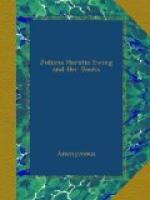During her residence at Aldershot Julie wrote three of her longest books—“A Flat Iron for a Farthing,” “Six to Sixteen,” and “Jan of the Windmill,” besides all the shorter tales and verses that she contributed to the Magazine between 1870 and 1877. The two short tales which seem to me her very best came out in 1876, namely, “Our Field” (about which I have already spoken) and “The Blind Man and the Talking Dog.” Both the stories were written to fit some old German woodcuts, but they are perfectly different in style; “Our Field” is told in the language and from the fresh heart of a Child; whilst the “Blind Man” is such a picture of life from cradle to grave—aye, and stretching forward into the world beyond,—as could only have come forth from the experiences of Age. But though this be so, the lesson shown of how the Boy’s story foreshadows the Man’s history, is one which cannot be learned too early.
Julie never pictured a dearer dog than the Peronet whom she originated from the fat stumpy-tailed puppy who is seen playing with the children in the woodcut to “Our Field.”
People sometimes asked us what kind of a dog he was, but we never knew, except that he was the nicest possible kind.... Peronet was as fond of the Field as we were. What he liked were the little birds. At least, I don’t know that he liked them, but they were what he chiefly attended to. I think he knew that it was our field, and thought he was the watch-dog of it; and whenever a bird settled down anywhere, he barked at it, and then it flew away, and he ran barking after it till he lost it; by that time another had settled down, and then Peronet flew at him, all up and down the hedge. He never caught a bird, and never would let one sit down, if he could see it.
Then what a vista is opened by the light that is “left out” in the concluding words:—
I know that Our Field does not exactly belong to us. I wonder whom it does belong to? Richard says he believes it belongs to the gentleman who lives at the big red house among the trees. But he must be wrong; for we see that gentleman at church every Sunday, but we never saw him in Our Field.
And I don’t believe
anybody could have such a field of their very
own, and never come
to see it, from one end of summer to the other.
It is almost impossible to quote portions of the “Blind Man” without marring the whole. The story is so condensed—only four pages in length; it is one of the most striking examples of my sister’s favourite rule in composition, “never use two words where one will do.” But from these four brief pages we learn as much as if four volumes had been filled with descriptions of the characters of the Mayor’s son and Aldegunda,—from her birthday, on which the boy grumbled because “she toddles as badly as she did yesterday, though she’s a year older,” and “Aldegunda sobbed till she burst the strings of her hat, and the boy had to tie them afresh,”—to the day of their wedding, when the Bridegroom thinks he can take possession of the Blind Man’s Talking Dog, because the latter had promised to leave his master and live with the hero, if ever he could claim to be perfectly happy—happier than him whom he regarded as “a poor wretched old beggar in want of everything.”




